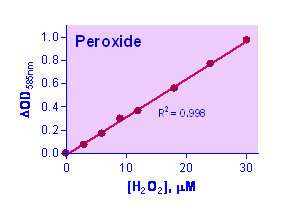
过氧化物测试盒
产品名称: 过氧化物测试盒
英文名称: QuantiChrom™ Peroxide Assay Kit
产品编号: DIOX-048, DIOX-250
产品价格: 0
产品产地: 美国
品牌商标: BioAssay Systems(美国博世)
更新时间: null
使用范围: null
- 联系人 :
- 地址 : 成都市新都区泰兴普河工业园105号
- 邮编 :
- 所在区域 : 四川
- 电话 : 点击查看
- 传真 : 点击查看
- 邮箱 : support@basbioinc.com
|
Description Peroxide (e.g. hydrogen peroxide H2O2) is one of the key reactive oxygen species formed under oxidative stress conditions. High levels of peroxide formation have been linked to pathological conditions such as ageing, asthma, diabetes, atherosclerosis, cataract, inflammatory arthritis and neurodegenerative diseases. Simple, direct and automation-ready procedures for quantitative determination of peroxide find wide applications in research and drug discovery. BioAssay Systems peroxide assay kit is designed to measure peroxide concentration in biological samples without any pretreatment. The improved method utilizes the chromogenic Fe3+-xylenol orange reaction, in which a purple complex is formed when Fe2+ provided in the reagent is oxidized to Fe3+ by peroxides present in the sample. The intensity of the color, measured at 540-610nm, is an accurate measure of the peroxide level in the sample. The optimized formulation substantially reduces interference by substances in the raw samples.
Key features Sensitive and accurate. Enhanced color intensity using sorbitol. Detection range 0.2 mM (7 ng/mL) to 30 mM (1,020 ng/mL) H2O2 in 96-well plate assay. Simple and high-throughput. The procedure involves addition of a single detection reagent and incubation for 30 min. Can be readily automated as a high-throughput assay in 96-well plates for thousands of samples per day.
Applications: Direct Assays: H2O2 in biological samples (e.g. serum, citrate-plasma, urine, cell lysate, culture medium). Pharmacology: effects of drugs on peroxide metabolism.
Kit Contents (250 tests in 96-well plates) Reagent A: 1 mL Reagent B: 50 mL Standard: 100 mL 3% stabilized H2O2.
Kit shipped at room temperature. Storage conditions. The kit is shipped at room temperature. Store all reagents at 4 °C. Shelf life: 6 months after receipt.
Precautions: reagents are for research use only. Normal precautions for laboratory reagents should be exercised while using the reagents. Please refer to Material Safety Data Sheet for detailed information.
ProcedureS Sample Treatment: several chemicals are known to interfere and should be avoided in sample preparation. These include ascorbic acid, EDTA, heparin, DMSO (>0.02%), NP-40 (>0.6%), SDS (>0.12%), Tris (>8mM) and ethanol (>0.4%).
Samples can be analyzed immediately after collection, or stored in aliquots at –20 °C. Avoid repeated freeze-thaw cycles. Reagent Preparation: Equilibrate to room temperature before assay. Prepare enough Detection Reagent by mixing 1 volume of Reagent A with 100 volumes Reagent B. Procedure using 96-well plate: 1. Standards. Prepare fresh standards on the day of assay. Pipette 5 mL 3% H2O2 and mix well with 495 mL H2O in a 1.5-mL Eppendorf tube. Mix 5 mL of this solution with 1465 mL H2O. The final H2O2 concentration is 30 mM (labeled “Premix”). Dilute standard as shown in the Table. 2. Transfer 40 mL diluted standards and each sample into separate wells of a clear flat-bottom 96-well plate. Add 200 mL Detection Reagent to all standards and samples. |
3. Incubate 30 min at room temperature and read optical density at 540-610nm (peak absorbance at 585nm). Note: if in rare cases, precipitation occurs after adding the Detection Reagent to a sample, transfer the whole reaction mixture of this sample well into a 1.5-mL Eppendorf tube and centrifuge 2 min at 14,000 rpm. Carefully remove 200 mL supernatant into a clean well and read OD. Multiply the OD reading by 1.2 to account for the volume change.
CALCULATION Subtract blank OD (water, #8) from the standard OD values and plot the OD against H2O2 concentrations. Subtract blank OD from Sample OD. Determine the sample peroxide content from the standard curve. Conversions: 1 mM H2O2 equals 34 ng/mL or 34 ppb.
Materials Required, but not provided Pipetting devices and accessories, 96-well plates and plate reader.
EXAMPLES: Duplicate assays for goat serum, human serum, 293 cell culture medium and fresh human urine gave peroxide content of 8.7± 2.8, 14.2 ± 2.7, 2.4 ± 0.0 and 1.4 ± 0.6 mM (n = 2).
Standard Curve in 96-well plate assay
|

